Windows operating system allows users to create different partitions on a hard disk. They can use these hard disk partitions for different purposes, like installing Windows operating system, storing data, etc. All the partitions that you create on a hard disk are visible in File Explorer. You can access them by opening File Explorer. After opening File Explorer, some users found that their hard disk were missing. If a hard disk partition is not showing or missing in File Explorer, it is impossible to access data stored on it until you make it visible again. If your hard disk partitions are not showing in Windows 11/10, the solutions provided in this article are sure to help you fix the problem.
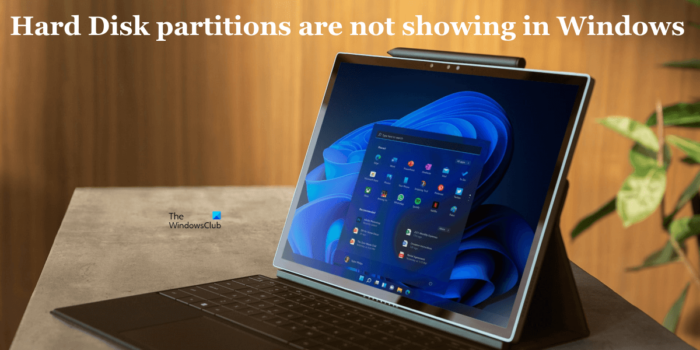
Hard Disk Partition not showing up in Windows 11/10
If for some reason, your Hard Disk Partition is not showing up in Windows 11/10, here are some suggestions that you should follow to fix this problem.
- Update your hard disk drivers
- Assign another drive letter
- Run Hardware and Devices Troubleshooter
- See if the hard disk partition is hidden or not
- Check for Unallocated disk partitions in the Disk Management
Let’s see all these fixes in detail.
1] Update your hard disk drivers
One possible cause of this issue is corrupted or outdated hard disk drivers. Hence, we suggest you update your hard disk drivers and see if it helps. To do so, download the latest version of your hard disk driver from the manufacturer’s website and install it manually on your system.
This should fix the issue.
2] Assign another drive letter
If a drive letter is not assigned to a hard disk partition, Windows will not show it in File Explorer. Open Device Management and see whether or not a drive letter is assigned to that partition. Do note that this solution does not work if you have an unallocated partition.
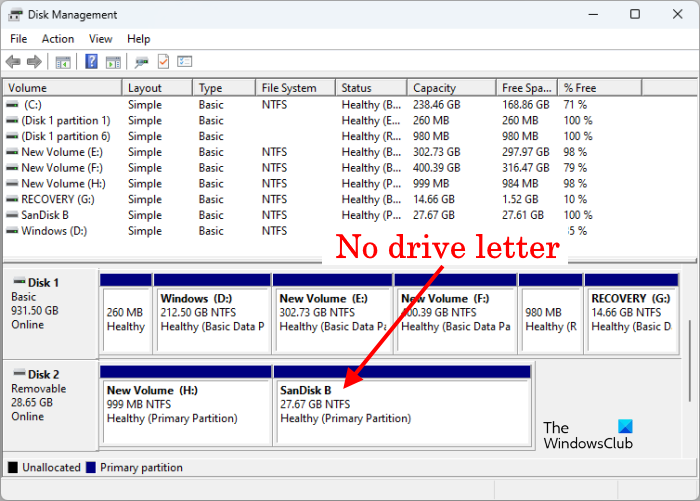
If Disk Management shows you the hard disk partition without a drive letter as shown in the above screenshot, follow the steps written below to assign a new drive letter.
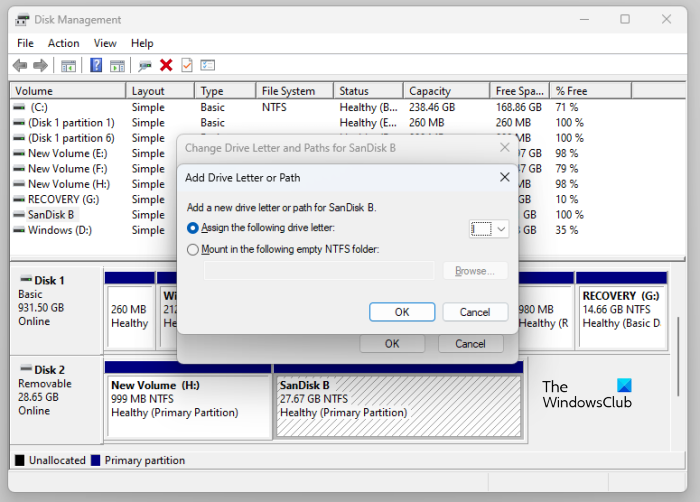
- Right-click on the hard disk partition and select Change drive letter and paths.
- Click Add.
- Select Assign the following drive letter and select a drive letter from the drop-down.
- Click OK.
Now, open File Explorer and you will see your hard disk partition there. If not, right-click and select Refresh. In Windows 11, right-click and go to “Show more options > Refresh.”
3] Run Hardware and Devices Troubleshooter
Hardware and Devices Troubleshooter is an automated tool that helps users fix hardware-related problems (if possible). Your hard disk partitions are not showing. Therefore, running the Hardware and Devices Troubleshooter can fix the issue. This troubleshooter is not available in Windows 11/10 Settings. Therefore, you have to execute the following command in the Administrator Command Prompt:
msdt.exe -id DeviceDiagnostic
4] See if the hard disk partition is hidden or not
Windows 11/10 allows users to hide a particular or all hard disk partitions. You can do this by configuring the Local Group Policy settings (not for Windows 11/10 Home edition users) and modifying the Windows Registry. If you have a shared computer and all your family members have access to the administrator account on your system, it might be possible that any of them has hidden the hard disk partition(s) by configuring the Local Group Policy Setting or modifying the Registry.
Open the Local Group Policy Editor and go to the following path:
User Configuration/Administrative Templates/Windows Components/File Explorer
Look for the “Hide these specified drives in My Computer” policy setting on the right side. If it shows Configured, double-click on it and select Not configured. After that, click Apply and then click OK.
To check the same in Windows Registry, Open the Registry Editor and go to the following path. Before you proceed, it is recommended to create a System Restore Point and backup your Registry.
Computer\HKEY_CURRENT_USER\Software\Microsoft\Windows\CurrentVersion\Policies\Explorer
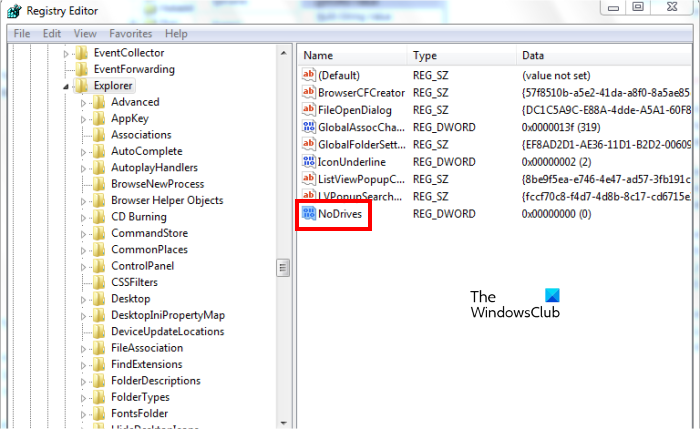
Make sure that you have selected the Explorer key on the left side. Look for the NoDrives Value on the right side. If the Value is there, delete it.
After performing the above steps, restart your computer. You will see the hidden hard disk partitions in File Explorer after restarting your computer.
5] Check for Unallocated disk partitions in the Disk Management
An unallocated partition represents that the space is unallocated on the hard disk. Some affected users have reported that their hard disks showed unallocated space. You should also check this. The following steps will guide you on this:

- Press the Win + X keys and select Disk Management. Alternatively, type diskmgmt.msc in the Run command box to open Disk Management.
- You will see the unallocated space on your hard disk (if it exists).
Unallocated hard disk partitions are not displayed in File Explorer until a new volume is created. Problems can occur at any time. Therefore, it is always suggested to back up your data on an external storage device. If you have not backed up your data, you can still fix the unallocated hard disk partition without data loss.
If none of the above solutions fixed the problem, you have to format the hard disk partition and create a new simple volume on it to make it reappear in File Explorer. If the hard disk partition is showing Unallocated, you can format it while creating a new simple volume. The following steps will help you with that:
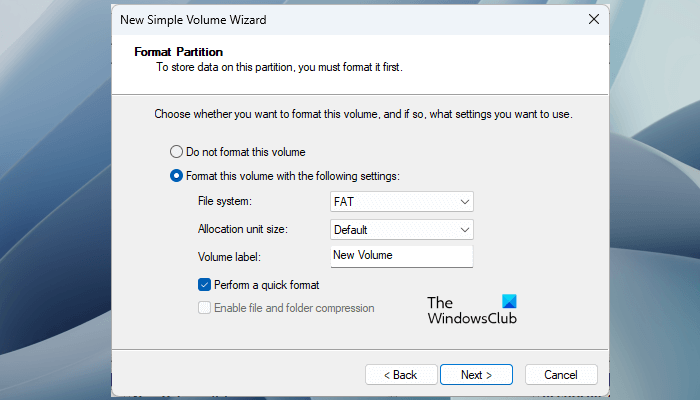
- Right-click on the unallocated partition and select New Simple Volume.
- The new simple volume creation wizard will open. Click Next.
- Enter the size in the required space or leave it to the default value.
- Click Next.
- Assign a new drive letter and click Next.
- On the next screen, select Format this volume with the following settings.
- Select File system and click Next.
- Now, click Finish.
Hard drive keeps disappearing and reappearing
If your Hard drive keeps disappearing and reappearing randomly on your Windows computer, run a ChkDsk test, update your device drivers, update BIOS and use a free software to check the health of the disk drive. If this does not help, we recommend you get it checked by a technician.
Read: What to do if a hard drive has deleted data by itself.
How do I access partitions in Windows 11?
All the hard disk partitions accessible by users are displayed in File Explorer. However, other partitions remain hidden in File Explorer because they do not have a drive letter. These partitions include System Reserved Partition, EFI Partition, Recovery Partition, etc. You must open the Disk Management app to view all the partitions on the hard disk(s) in Windows 11.
How to fix my hard disk partition not showing in Windows?
A hard disk partition remains hidden in the following two cases:
- When the partition space is unallocated.
- When there is no drive letter assigned to the partition.
To make a hard disk partition visible in File Explorer, you have to open the Disk Management app and see which one of the above two cases is true. If the partition space is unallocated, create a new simple volume to make it visible in File Explorer. This process requires formatting of the hard disk partition.
If you have data on your hard disk partition but Disk Management shows its space as unallocated, you cannot use the above method because it will delete all the data on the hard disk partition. To deal with such a situation, you can use other methods to fix unallocated space on a hard disk partition without deleting data stored on it. We have talked about this method above in this article.
If there is no drive letter assigned to the partition, assign a new drive letter via the Disk Management app. After assigning a new drive letter to the affected partition, it will become visible in File Explorer.
Other causes of missing or hidden hard disk partitions include hard disk errors, outdated or corrupted hard disk drivers, and virus infection. In such a situation, run a chkdsk scan, run an antivirus scan, and update your hard disk drivers.
Read next: How to increase Hard Drive speed & improve performance in Windows.
Leave a Reply